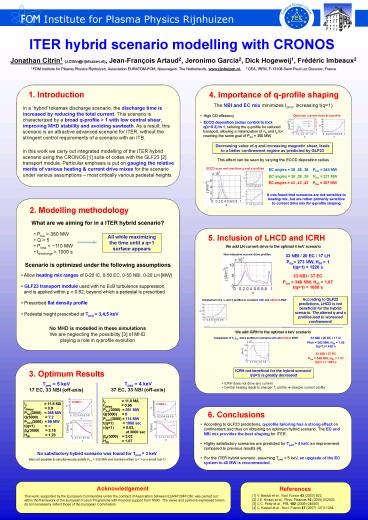ITER hybrid scenario modelling with CRONOS
1 / 1
Title:
ITER hybrid scenario modelling with CRONOS
Description:
... .nl), Jean-Fran ois Artaud2, Jeronimo Garcia2, Dick Hogeweij1, Fr d ric Imbeaux2 ... satisfy Pfus = 350 MW and maintain either q 1 or a small r(q=1) ... –
Number of Views:23
Avg rating:3.0/5.0
Title: ITER hybrid scenario modelling with CRONOS
1
Trilateral Euregio Cluster
Institute for Plasma Physics Rijnhuizen
ITER hybrid scenario modelling with CRONOS
Jonathan Citrin1 (J.Citrin_at_rijnhuizen.nl),
Jean-François Artaud2, Jeronimo Garcia2, Dick
Hogeweij1, Frédéric Imbeaux2 1 FOM Institute for
Plasma Physics Rijnhuizen, Association
EURATOM-FOM, Nieuwegein, The Netherlands,
www.rijnhuizen.nl, 2 CEA, IRFM, F-13108 Saint
Paul Lez Durance, France
1. Introduction
4. Importance of q-profile shaping
The NBI and EC mix minimizes Iohm, increasing
t(q1)
In a hybrid tokamak discharge scenario, the
discharge time is increased by reducing the
total current. This scenario is characterized by
a broad q-profile gt 1 with low central shear,
improving MHD stability and avoiding sawteeth.
As a result, this scenario is an attractive
advanced scenario for ITER, without the
stringent control requirements of a scenario
with an ITB.
- High CD efficiency
- ECCD deposition radius control to lock
q(x0.3) to 1, tailoring the q-profile for
reduced transport, allowing a minimization
of ne and Ip for reaching the same goal of
Pfus 350 MW
Optimum current drive q-profile
Decreasing value of q and increasing magnetic
shear, leadsto a better confinement regime as
predicted by GLF23
In this work we carry out integrated modelling of
the ITER hybrid scenario using the CRONOS 1
suite of codes with the GLF23 2 transport
module. Particular emphasis is put on gauging the
relative merits of various heating current
drive mixes for the scenario under various
assumptions most critically various pedestal
heights.
This effect can be seen by varying the ECCD
deposition radius
It was found that scenarios are not sensitive to
heating mix, but are rather primarily sensitive
to current drive mix for q-profile shaping
2. Modelling methodology
What are we aiming for in a ITER hybrid scenario?
5. Inclusion of LHCD and ICRH
We add LH current drive to the optimal 4 keV
scenario
33 NBI / 20 EC / 17 LHPfus 273 MW, H98
1t(q1) 1220 s 33 NBI / 37 ECPfus 348
MW, H98 1.07t(q1) 1050 s
Scenario is optimized under the following
assumptions
- Allow heating mix ranges of 0-20 IC, 0-50 EC,
0-50 NBI, 0-20 LH MW - GLF23 transport module used with no ExB
turbulence suppression, and is applied within ?
0.82, beyond which a pedestal is prescribed - Prescribed flat density profile
- Pedestal height prescribed at Tped 3,4,5 keV
According to GLF23 predictions, LHCD is not
beneficial for the hybrid scenario. The altered q
and s profiles lead to worsened confinement!
No MHD is modelled in these simulationsWe are
neglecting the possibility 3 of MHDplaying a
role in q-profile evolution
We add ICRH to the optimal 4 keV scenario
33 NBI / 20 EC / 17 IC Pfus 362 MW, H98
1.05t(q1) 420 s33 NBI / 37 ECPfus 348
MW, H98 1.07 t(q1) 1050 s
ICRH not beneficial for the hybrid scenario!
t(q1) is greatly decreased
3. Optimum Results
Tped 4 keV 37 EC, 33 NBI (off-axis)
Tped 5 keV 17 EC, 33 NBI (off-axis)
- ICRH does not drive any current
- Central heating leads to sharper Te profile ?
sharper current profile
Ip 11.8 MAfGWald
0.95 Pfus(3000) 351 MWQ(3000)
5Ploss(3000) 114 MWt(q1) 1050
secr(q1) 0.02,
at 3000 secßN(3000) 2.02H98
1.07
Ip 11.5 MAfGWald
0.9 Pfus(3000) 365 MWQ(3000)
7.2Ploss(3000) 99 MWt(q1) 8
ßN(3000) 2.15H98 1.23
6. Conclusions
- According to GLF23 predictions, q-profile
tailoring has a strong effect on confinement
and thus on obtaining an optimum hybrid scenario.
The EC and NBI mix provides the best shaping
for ITER. - Highly satisfactory scenarios are predicted for
Tped gt 4 keV, an improvement compared to
previous results 4. - For the ITER hybrid scenario, assuming Tped lt 5
keV, an upgrade of the EC system to 40 MW is
recommended.
Acknowledgement
References
1 V. Basiuk et al., Nucl Fusion 43 (2003)
822. 2 J.E. Kinsey et al., Phys. Plasmas 12
(2005) 052503. 3 C.C. Petty et al., PRL 102
(2009) 045005 4 C. Kessel et al., Nucl. Fusion
47 (2007) 1274-1284.
This work, supported by the European Communities
under the contract of Association between
EURATOM/FOM, was carried out within the framework
of the European Fusion Programme with financial
support from NWO. The views and opinions
expressed herein do not necessarily reflect those
of the European Commission.































